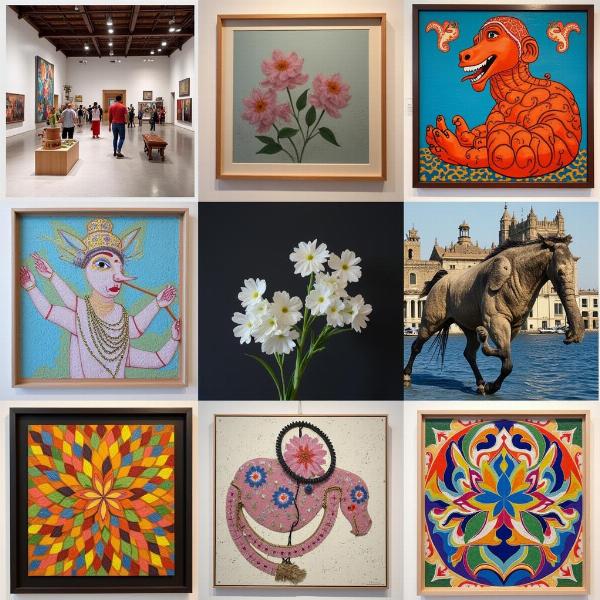Understanding the meaning of “fine arts” in Hindi requires more than just a simple translation. It involves delving into the cultural nuances and artistic traditions that shape its interpretation. This article explores the various aspects of “fine arts” in the Indian context, offering a comprehensive understanding of its meaning, significance, and relevance. We’ll cover everything from traditional art forms to modern expressions, providing you with a complete picture of “fine arts meaning in hindi”.
Exploring the Essence of Fine Arts in India
In Hindi, “fine arts” is often referred to as “ललित कला” (lalit kala). This term encompasses a wide range of artistic disciplines, each with its unique history and cultural significance. From painting and sculpture to music and dance, “lalit kala” reflects India’s rich artistic heritage. However, the term isn’t merely a label; it represents a deep-rooted appreciation for aesthetics and creativity that has been integral to Indian culture for centuries.
The concept of “fine arts” goes beyond mere technical skill. It embodies a spiritual and philosophical dimension, often linked to the expression of emotions, storytelling, and religious beliefs. For instance, traditional Indian paintings often depict mythological stories and religious figures, serving as a visual medium for conveying spiritual messages. Similarly, classical Indian dance forms like Bharatanatyam and Kathak are deeply intertwined with mythology and spirituality.
Delving into Specific Art Forms
Painting (चित्रकला – Chitrakala)
Indian painting boasts a diverse range of styles and techniques, from the miniature paintings of the Mughal era to the vibrant folk art of rural India. Each style carries its distinct characteristics and reflects the cultural influences of the region it originates from.
Sculpture (मूर्तिकला – Murtikala)
Indian sculpture, with its intricate details and symbolic representations, has played a significant role in religious and cultural practices. From the ancient temple carvings to the modern bronze sculptures, “murtikala” showcases the artistic mastery of Indian artisans.
Music (संगीत – Sangeet)
Indian classical music, with its complex melodic structures and rhythmic patterns, is a testament to the country’s musical heritage. From the soulful strains of the sitar to the rhythmic beats of the tabla, “sangeet” holds a prominent place in Indian culture.
Dance (नृत्य – Nritya)
Indian classical dance forms, with their expressive movements and intricate gestures, tell stories and convey emotions with grace and elegance. These dance forms are not just a performance art; they are a form of spiritual expression and cultural preservation.
Fine Arts in Modern India
While traditional art forms continue to thrive, modern India has witnessed the emergence of new artistic expressions. Contemporary Indian artists are exploring new mediums and themes, pushing the boundaries of creativity and challenging conventional notions of art.
 Modern Indian Art Expressions
Modern Indian Art Expressions
Fine Arts Meaning in Hindi: FAQs
- What is the exact Hindi translation of “fine arts”? The most common translation is “ललित कला” (lalit kala).
- What are the main forms of fine arts in India? The main forms include painting, sculpture, music, dance, and theatre.
- How is fine arts viewed in Indian culture? Fine arts are deeply respected and considered a form of spiritual and cultural expression.
- What is the difference between traditional and modern fine arts in India? While traditional art forms are often rooted in mythology and religion, modern art explores contemporary themes and utilizes new mediums.
- Where can I learn more about fine arts in India? Museums, art galleries, cultural centers, and universities offer resources and programs to study Indian art.
- Are there any famous Indian fine artists? Yes, India has a rich history of renowned artists in various disciplines. Some prominent names include Raja Ravi Varma, M. F. Husain, and Amrita Sher-Gil.
- How can I appreciate fine arts better? By studying the history, symbolism, and techniques employed in different art forms, you can develop a deeper appreciation for their beauty and significance.
Conclusion
“Fine arts meaning in hindi” encompasses a vast and vibrant landscape of artistic expression. From traditional forms deeply rooted in culture and spirituality to modern interpretations that push creative boundaries, “lalit kala” continues to evolve and enrich Indian society. Understanding the nuances of its meaning allows us to appreciate the profound impact of art on Indian life and culture.
Related Articles
Meaning-Hindi.in offers professional translation services specializing in various fields, including business, legal, technical, website localization, educational, and specialized content. Whether you need accurate translations of business documents or culturally sensitive adaptations of your website content, our expert linguists ensure quality and precision. For all your Hindi translation needs, contact us at [email protected] or call us at +91 11-4502-7584. Meaning-Hindi.in is your trusted partner for bridging language barriers and connecting cultures.